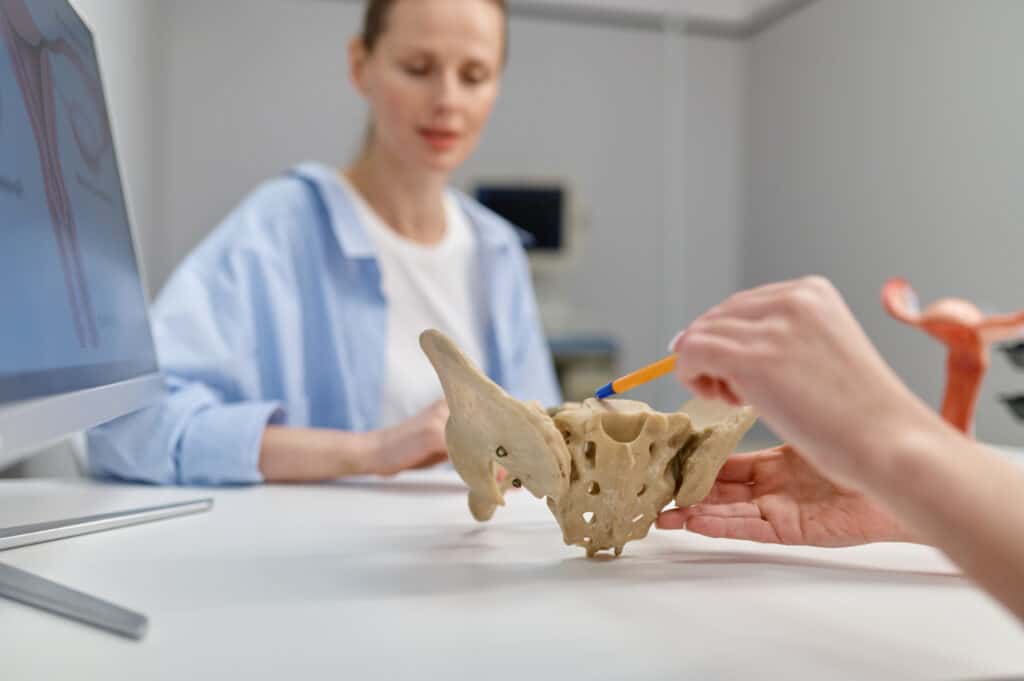
As women, we know that our bodies are capable of incredible things – but with all that power comes the possibility of complications.
One of those complications is uterine prolapse, a condition where the womb descends into the vaginal canal due to weakened pelvic floor muscles.
Though it may be uncomfortable to talk about, it’s important to understand the basics of uterine prolapse and the potential treatments, such as pelvic floor therapy.
If you’re a woman with pelvic floor weakness, changes in your menstrual cycle, or painful intercourse, it may be possible that you’re suffering from one of the stages of uterine prolapse.
It is an uncomfortable and sometimes painful condition that can put you at risk for potential complications unless you address it promptly.
As women, we experience various changes in our bodies throughout our lives. These changes have different implications for our health and require medical attention.
Uterine prolapse is one of the many conditions that can affect us at times of great hormonal change, such as after childbirth, menopause, or due to some underlying medical conditions.
Uterine prolapse is an all-too-common problem for women, with some estimates suggesting that up to 50% of women may experience it at some point in their lives.
It’s a condition that can cause pain and extreme discomfort, and many people are left wondering what the best course of treatment is. In this blog, we explore the stages of uterine prolapse and the implications of not receiving treatment for each stage.
We also help you determine if you have the symptoms of uterine prolapse and which stage of uterine prolapse you have.
But if you do determine that you have the symptoms of uterine prolapse, it’s essential to get an accurate diagnosis and proper care from a pelvic floor physical therapist right away to prevent more serious health issues later in life.
More Blogs From Nancy Branberg
Should I Be Concerned About Pelvic Hernias?
Hypertonic Pelvic Floor: Symptoms, Causes & Treatment
What Are Kegel Exercises, And Should I Be Doing Them?
What Is An Uterine Prolapse?

Uterine prolapse is a condition that affects women of all ages. It can be a frightening experience for women who may not be aware of what it is or what causes it.
Essentially, uterine prolapse is when the pelvic muscles and ligaments no longer provide enough support to keep the uterus in place, causing it to slip into the vaginal canal.
This process can happen for various reasons, such as childbirth, menopause, or age-related weakening of the pelvic muscles. However, it’s most common in older women or those who have given birth.
The causes of uterine prolapse include weak pelvic floor muscles, hormonal changes, and pregnancy and childbirth. In severe cases, you may need surgery to correct the prolapse.
However, with proper prevention and treatment from a specialist physical therapist, you can manage this condition and maintain your quality of life.
What Are The Different Stages Of A Uterine Prolapse?
Uterine prolapse occurs when the uterus (womb) descends and bulges into the vagina due to weakened pelvic muscles and ligaments.
This dropping can happen in varying degrees, and we classify it into different stages depending on the severity of the condition.
Understanding the stages of uterine prolapse and which one you have is crucial to treating the condition. Still, as we’ve already mentioned, you need a trained physical therapist to diagnose accurately.
- The first degree of uterine prolapse is when the cervix drops into the lower portion of the vagina.
- The cervix extends outside the body in the second degree, but the uterus is still within the vagina.
- The third degree involves the uterus protruding outside the vaginal opening.
- In contrast, the fourth degree is the most severe form, where the uterus is outside the body.
Early Warning Signs & Symptoms of Uterine Prolapse

The symptoms of uterine prolapse may include discomfort, pain, or pressure in the pelvic area, difficulty urinating, and spotting or bleeding.
While some women with uterine prolapse experience no symptoms, others may notice a few key warning signs. These can include:
- feelings of pelvic pressure or fullness
- a bulging sensation in the vaginal area
- difficulty passing urine
If you notice any of these symptoms, contacting a pelvic floor physical therapist is important. Proper diagnosis and treatment enable you to effectively manage your uterine prolapse, avoid surgery, and improve your quality of life.
How We Diagnose & Treat Uterine Prolapse
Uterine prolapse is a condition that can significantly impact your quality of life. Symptoms range from mildly uncomfortable to severe pain and difficulty performing daily tasks.
If you suspect uterine prolapse, it’s important to get help. When you come and see us with a suspected uterine prolapse, we conduct a physical exam and ask about your symptoms to determine the severity and stage of your prolapse.
If we do determine that you have uterine prolapse, don’t worry. There are several treatment options available, ranging from lifestyle changes to surgery.
We work with you to create a treatment plan that addresses your unique needs and goals and teaches you how to manage your uterine prolapse and reclaim your quality of life.
How To Cope With A Uterine Prolapse

Uterine prolapse can be a frustrating and distressing condition for many women. However, it’s important to try and stay positive and use the following tips to cope with the condition and prevent worsening symptoms:
If your symptoms are mild, performing pelvic floor exercises can help to strengthen the muscles that provided support to the uterus and prevent prolapse from occurring in the first place and/or worsening.
Maintaining a healthy weight, avoiding lifting heavy objects, and stopping smoking also reduce uterine prolapse risk and prevent worsening symptoms.
If you’re already experiencing more severe symptoms, there are several coping mechanisms available, such as using a pessary or undergoing surgery followed by pelvic floor rehabilitation with a trained pelvic floor specialist.
We can help you determine the best course of action for your symptoms and set the wheels in motion. Just remember that prevention and early intervention are crucial to managing uterine prolapse.
Waiting too long before seeking medical intervention can lead to complications such as incontinence, back pain, and infections.
What Is The Best Treatment For Uterine Prolapse?
Well, the most important thing to remember is that uterine prolapse is treatable. Many women mistakenly believe that it’s just something they must put up with. It isn’t. We can help.
You can also do some things at home to reduce the severity of your symptoms, including lifestyle changes, such as eating a healthier diet and starting an exercise routine.
These changes impact your overall health and well-being. Still, they also directly and profoundly affect uterine prolapse symptoms.
Doing pelvic floor exercises (aka Kegels) can specifically target the issues like urinary incontinence that sometimes accompany a uterine prolapse.
But it probably won’t surprise you to learn that the most effective treatment for uterine prolapse is targeted physical therapy with a specialist pelvic floor therapist.
If you have physical therapy at the first sign of symptoms, it can massively improve your quality of life (including your sex life) and help you avoid surgery.
What Is Pelvic Floor Physical Therapy

And How Does It Help With Uterine Prolapse?
Pelvic floor health is an essential aspect of overall well-being, but it’s often overlooked. However, maintaining good pelvic floor health is crucial, especially as we age.
Pelvic floor therapy involves specialized exercises that strengthen the muscles and tissues in the pelvis to help support organs such as the uterus and bladder.
If you’ve ever experienced bladder leakage or pelvic pain, you may have heard of pelvic floor therapy as a treatment option. It’s a non-invasive treatment that helps women resolve issues with their pelvic floor muscles.
A pelvic floor is a group of muscles inside your pelvis that support the bladder, uterus, and rectum. When these muscles become weak or tighten, it can lead to various symptoms.
Pelvic floor therapy uses targeted exercises and hands-on physical therapy techniques to improve muscle strength and flexibility, ultimately eliminating or reducing these uncomfortable symptoms.
We work with you to regain control over your pelvic muscles – get them working for you again instead of against you to reduce pain and discomfort and improve your urinary and bowel function.
Pelvic floor therapy can also prevent the need for surgery in some cases, which is a major benefit for women looking to avoid more invasive medical procedures.
But if your uterine prolapse is already at an advanced stage, we (and your OBgyn) determine that surgery is the only option. That’s ok too.
Surgical treatments have come a long way in the field of medicine. Today, various types of surgery are performed for uterine prolapse. Surgeons use state-of-the-art technology and techniques to ensure the best possible outcome.
However, it’s important to remember that what comes after surgery (i.e., pelvic floor physical therapy and the at-home exercises we teach you) is just as important as the surgery itself.
Proper post-operative care and following the surgeon’s recommendations after uterine prolapse surgery can help minimize complications and promote healing, assisting you to get back to your everyday life as soon as possible.


